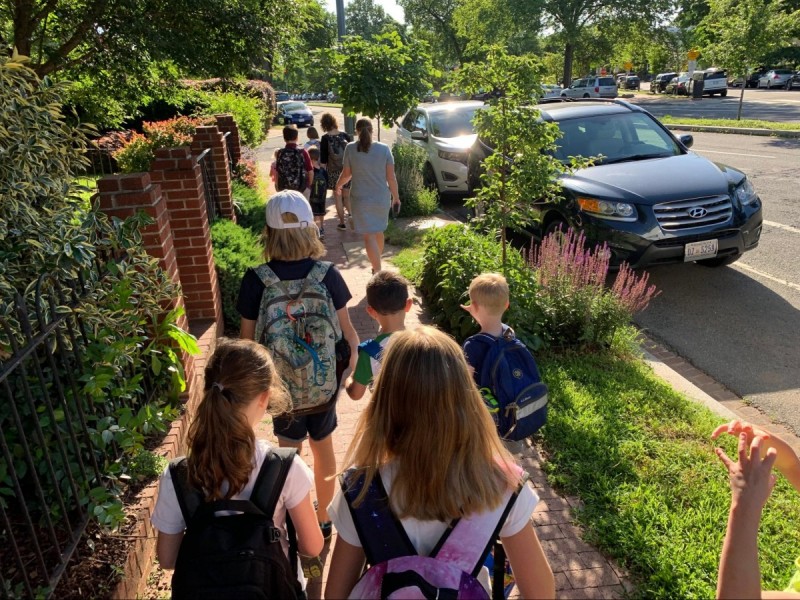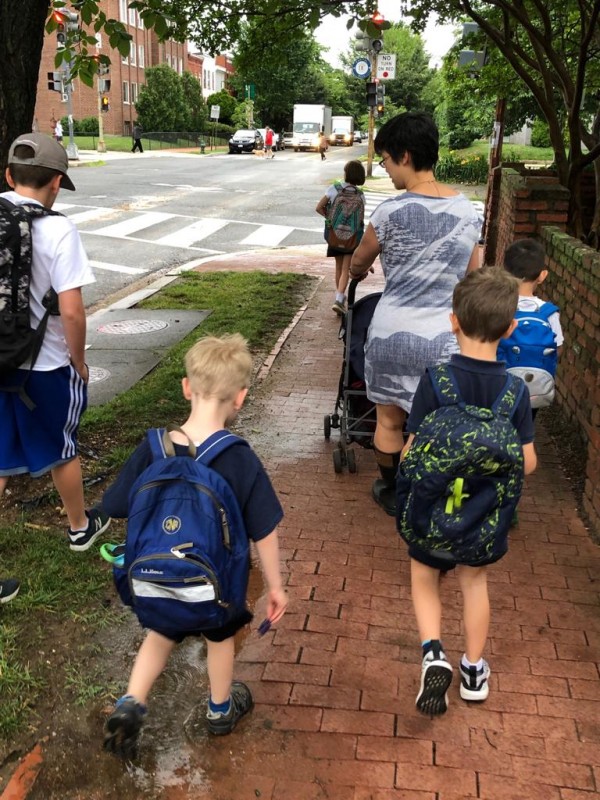These ‘magic school buses’ give kids safe, fun, and healthy walking routes to class

A walking school bus in action in Capitol Hill. Image by Amber Gove used with permission.
It’s back to school time for kids across the Washington region, and some families are already puzzling over the first practical exercise: How to get them there. A “walking school bus” could be the solution. It gets several kids to walk to school together (with at least one adult escort), and all it takes is a little organization, a route people can follow, and showing up.
Read on, but note: There will be a quiz.
I walk the line
Any caregiver for a kid in institutionalized education is familiar with the challenge of getting them where they’re going safely, on time, every single day, well before your own day’s assignments come into play. I’ve been doing this with mine since they were a year old. As a non-morning-person, I can only speculate this is part of how society tacitly yet mercilessly resists population growth.
Last fall, I had a problem. I cover mornings with our kids because my spouse leaves for work by 6:30 am every day. Our son was given a place at our in-bounds public elementary school, but one of the factors holding us back from taking it was the logistics. One child needed to be delivered to RFK Stadium/Kingman Park, and the other had to get to the Golden Triangle downtown, leaving me with the dreaded Divergent Dropoff scenario that no parent welcomes.
Short of driving all over town every morning while rueing my life choices, how was I going to get everyone where they needed to go, and get to work at a decent hour?
The walking school bus of Constitution Avenue came to my rescue. Local parents formed the bus in order to get their kids to the same co-located elementary and middle schools. Every morning at 8:05, the designated escort would be at the first house on the route and start walking, picking up each kid as their parents cheerily popped them out of their front doors. We used a What’s App group to stay in contact about departures, arrivals, and any kids who wouldn’t be “on the bus” that day.
Participating in this system was great for our family, and it helped make it feasible for us to send our kid to school instead of another year of expensive daycare. Aside from the practical benefits of only needing to transport one’s kid a couple times a week instead of five, families who took part enjoyed wider benefits too.
“The bus was particularly helpful for us, because more than just transport and lessening the parenting burden, it was about community,” says Stephanie Winans, a parent on our bus who had recently moved to DC. “We got to know our neighbors so much better, and our children started school with a sense of confidence that comes from being part of the community.”
Getting their 10,000 steps in (no children were made to wear FitBits as part of this exercise). Image by the author.
(How to) walk this way
How does one go about forming a walking school bus? The walking school bus website suggests starting small with a few families, a route, and a schedule. It’s easiest to begin by talking to families who live in a concentrated geographic area who need to get to the same school or co-located schools. From there, you can recruit other families who are interested in their kids taking part.
I spoke to a coordinator for our walking school bus last year, Advisory Neighborhood Commissioner Amber Gove (6A04), to find out how the magic happens. She supplied some tips:
- Host a playdate to recruit families (extra credit if they’re on or near a sensible route to get to school), and discuss ground rules and expectations. Putting out a call on a school or neighborhood list serve can be a good way to recruit people.
- Build a Google Sheet with parent and child contact information, and a regular bus “driver” schedule that everyone can edit.
- Start a WhatsApp Group with all “bus driver”/caregiver cell phone numbers, and manage all communications through that channel. Set expectations about communication, like indicating if a kid won’t be joining the bus that day. What’s App is a good option because some phones won’t facilitate large group texts.
- “Bus drivers” must commit to their day and get a replacement if they can’t make it.
- Pick one route, and stick to it. Kids get better (and less prone to wander) as they get familiar with a single route. This also helps the occasional latecomer.
- Ground rules can include things like kids holding hands while crossing the street and roughly how the adults should position themselves. For us, a leader, caboose, and someone in the middle to carefully monitor street crossings worked well.
Day walkers. Image by Amber Gove used with permission.
Walk, don’t drive
The temptation to drive kids to school can be strong for caregivers with access to a car. But driving around schools creates all sorts of problems. The chaos of morning dropoff periods mean that children, who can be distracted, small, or both, are at risk from cars driven by people thinking about their own kids or schedules. Drivers hit four children and caregivers near DC schools in the first week of the 2018-19 school year alone, three of whom were in Ward 8.
Immediate safety aside, a long line of cars can jam up the roads, and idling vehicles also pollute the air those same kids breathe. Our bus coordinator calculated that our bus of 10 families avoided putting 2.2 metric tons of carbon into the atmosphere last year by eschewing driving. It’s far better, of course, to walk, bike, or take public transport if you can. A walking school bus is one way of making the pedestrian option more feasible.
While we press our elected officials harder to design safer streets through structural programs like Safe Routes to School, walking school buses can provide protection in numbers, while kids get the benefits of starting or ending the day with a healthy walk.
We promise, kids, when the C Street NE project is finished, it will be safer to walk to school. Image by Amber Gove used with permission.
A good supplement to gym class
Most of us could use (a lot) more exercise, and for kids, it’s especially important as their bodies grow and develop. At least 60 minutes of active play per day is recommended for children aged six and older by the American Academy of Pediatrics. But DC Public Schools guidelines only mandate 20 minutes of recess per day. Something doesn’t add up.
Sure, kids could hypothetically be getting physical activity at other times of day. But the time available for exercise outside the school day is limited, especially for kids whose caregivers work and who may spend time in aftercare once the final bell has rung. A walking school bus builds outdoor activity into the beginning or end of every day.
Weather may be less of a barrier than you think: Through all of the last school year, the group only shifted to carpool one morning in January (it was 17 degrees and snowing hard), and otherwise the kids were reasonably pliant.
Kids looking super jazzed about walking in the snow. Image by Amber Gove used with permission.
Today’s lesson: Sharing is caring
Caregivers rotate responsibility for escorting the walking school bus, making scheduling and punctuality (ahem, harder for some of us than others) important. Our bus had around ten families involved at different points of the year and up to 14 kids ranging from age three to 12.
We agreed we needed three adults to manage the journey safely each day, so we eventually settled on a pattern in which each family would cover the same couple slots each week, more or less. In time, we all came to appreciate the broader benefits of our kids building a wider network of caring adults in their neighborhoods, surely one of the most important devices in the urban parent’s toolkit.
“I think it really reinforces an extended sense of community and [a] village approach to parenting,” says Gove. “We’ve got a long list of back-up parents and caregivers we can rely on—which makes parenting in this busy age so much more manageable. We could all use a little more village in our lives.”
The walking schoolbus celebrates the last day of school. Image by Tomas Bonome used with permission.
Pop quiz
The start of the school year, perhaps even Walk to School Day on October 2, could be a great time to start a walking school bus in your community.
Let’s review how they can be beneficial. Can a walking school bus:
A. Give kids (and adults) an opportunity to get healthier through daily exercise;
B. Share dropoff responsibility among caregivers from different families, and help build a sense of community;
C. Provide a practical alternative to driving, thereby reducing carbon emissions and the number of cars involved in the unpredictable school dropoff/pickup environment;
D. Be super fun; or
E. All of the above?
If you said “E,” give yourself a gold star! You’re ready to graduate to a walking school bus of your own.
